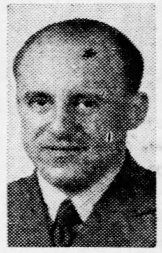Hanns Schimmerling
(also known as: Hans Schimmerling, Hanus Aldo Schimmerling)
Hanns Schimmerling was born on 5 September 1900 in Brno (Moravia, today Czech Republic) into a well-off family with his father being a dentist. He learned the piano at the age of 6 and the cello at the age of 11. From the age of 14 Hanns Schimmerling received lessons in music theory from Joseph Gustav Mraczek. He was not drafted for military service in World War I and so could finish his school in 1918. Hanns Schimmerling then moved to Vienna. He started to study medicine on demand of his father. But he quit medicine shortly afterwards and switched to law, all the while he continued his music studies as well. In 1920 Hanns Schimmerling moved to Prague and became a student of Alexander Zemlinsky at the "Deutsche Akademie für Musik und darstellende Kunst". Some sources also mention Franz Schreker and Frantisek Neumann as his teachers. He graduated in both law and music in 1924.
Hanns Schimmerling became the conductor of the German Opera in Prague in 1924/25. He then toured the US as a piano accompanist for a Berlin opera star, spent some time at the Metropolitan Opera in New York, enrolled a summer course at the Sorbonne in Paris and became the accompanist for Michael Bohnen, the leading Metropolitan Opera bass, in 1926. In 1928 Hanns Schimmerling moved back to Vienna where he worked as a pianist, composer and singer. In 1938 Hanns Schimmerling and his wife Mathylda fled from Vienna just before the invasion of Hitler. After a long trip via Prague and Trieste they finally arrived in New York. Hanns Schimmerling lived in New York for the next decade, worked as a composer, conductor, teacher and writer and became a US citizen in 1944. In the 1950s the Schimmerlings bought a house in Woodstock, NY and moved there. Hanns Schimmerling then taught music at different elementary schools in the area and developed different music school programs like "The American Parade" until his retirement in 1960.
Hanns Schimmerling died on 10 November 1967 in Kingston, NY.
Hanns Schimmerling was a promising young composer in the 1920s and 30s but his career was cut short by the rise of the Nazi regime and his emigration to the US. He could not requicken his reputation as a distinguished composer and sank more and more into oblivion. This neglect is unjustified and deplorable because Hanns Schimmerling was one of the up-and-coming composers in the 1920s. In a special issue of the music journal "Musikblätter des Anbruch" for the music festival in Prague in 1925 the author Erich Steinhardt mentioned five promising composers: Erwin Schulhoff, Fidelio Finke, Victor Ullmann, Hans Krasa and Hanns Schinmmerling! An illustrious list of names - the first four all became renowned composers with only Hanns Schimmerling being forgotten nowadays.
The work catalogue of Hanns Schimmerling comprises opera, orchestral and chamber music, songs and choral works. Due to a missing detailed online work catalogue I list here all the larger compositions by Hanns Schimmerling to give an overview on his oeuvre:
- Song cycle „Pierrot marie“ (1920)
- Oriental symphony for orchestra, organ, choir and solo „Der Fluch der Kröte“ (1921)
- Six miniatures, for chamber orchestra (1922)
- Lyrische Kammermusik, for strings, piano, clarinet and voice (1923)
- Symphonic poem for baritone and orchestra „Die Kirschblüte“ op.11 (1924)
- Burleske, for orchestra (1925)
- Piano trio op.12
- „Lustige Ouvertüre“, for orchestra op.16
- Sinfonietta parisienne, for orchestra and voice op.18 (1926)
- 40 songs for voice and piano or orchestra
- Song cycle „Der Gesang vom rollenden Globus“, for mens choir and piano (1937)
- Tumult in Tamberg, musical grotesque (1938)
- Viola sonata in C major (1939)
- String trio in G major (1939)
- Cantata for baritone, choir and orchestra „Ballade von der goldenen Schwelle“
- Cantata for baritone, choir and piano „Humphrey Potter“
- Frankie and Johnny, musical play op.39 (1941)
- Te Deum, for soli, chorus and orchestra (1944)
- Opera „Silvio Pellico“
- Symphony No.1 (1949)
- Toccata und Fuga chromatica, for organ (1949)
- Slavonian Rhapsody Concerto (1949)
- Requiem for solo, choir and orchestra (1950)
- Serenade for string quartet, piano and 3 female voices (1952)
- + many songs and choral works
Sinfonietta parisienne, for orchestra and voice op.18
In my possession is the autograph full score of the "Sinfonietta parisienne, for orchestra and voice op.18" by Hanns Schimmerling. The work was composed in 1925 and premiered on 7 November 1926 by the Orchester Stadttheater Brünn under Frantisek Neumann. The composition is dedicated to the city of Paris and a musical picture of different places in Paris. The 5 movements are:
- Le Carrefour de l'Opera
- Notre dame
- Montmartre
- La femme eternelle (En observant La Giaconde de Leonardo da Vinci et La Venus de Milo en Louvre)
- En avion au-dessus de la ville

